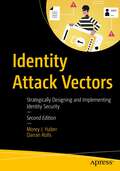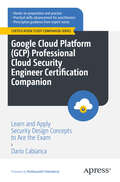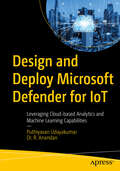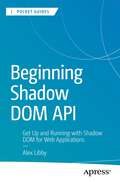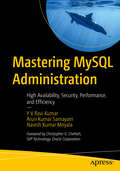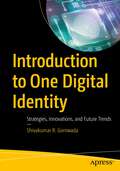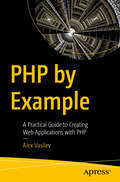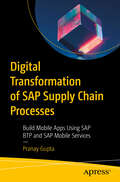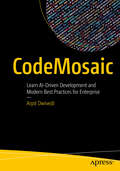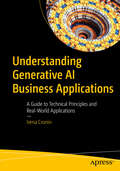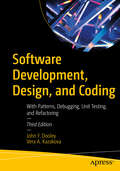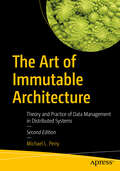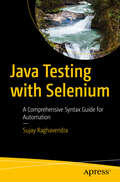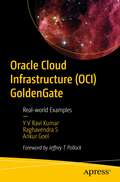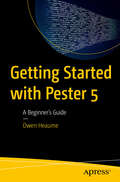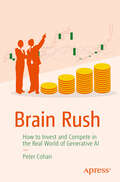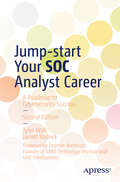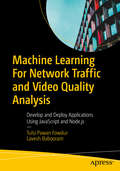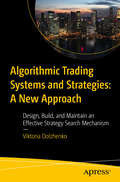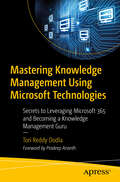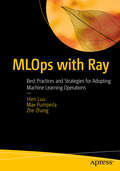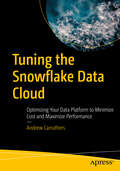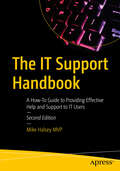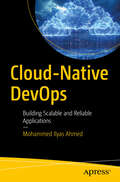- Table View
- List View
Identity Attack Vectors: Strategically Designing and Implementing Identity Security, Second Edition
by Morey J. Haber Darran RollsToday, it’s easier for threat actors to simply log in versus hack in. As cyberattacks continue to increase in volume and sophistication, it’s not a matter of if, but when, your organization will have an incident. Threat actors target accounts, users, and their associated identities—whether human or machine, to initiate or progress their attack. Detecting and defending against these malicious activities should be the basis of all modern cybersecurity initiatives.This book details the risks associated with poor identity security hygiene, the techniques that external and internal threat actors leverage, and the operational best practices that organizations should adopt to protect against identity theft, account compromises, and to develop an effective identity and access security strategy. As a solution to these challenges, Identity Security has emerged as a cornerstone of modern Identity and Access Management (IAM) initiatives. Managing accounts, credentials, roles, entitlements, certifications, and attestation reporting for all identities is now a security and regulatory compliance requirement. In this book, you will discover how inadequate identity and privileged access controls can be exploited to compromise accounts and credentials within an organization. You will understand the modern identity threat landscape and learn how role-based identity assignments, entitlements, and auditing strategies can be used to mitigate the threats across an organization’s entire Identity Fabric. What You Will Learn Understand the concepts behind an identity and how its associated credentials and accounts can be leveraged as an attack vectorImplement an effective identity security strategy to manage identities and accounts based on roles and entitlements, including the most sensitive privileged accountsKnow the role that identity security controls play in the cyber kill chain and how privileges should be managed as a potential weak linkBuild upon industry standards and strategies such as Zero Trust to integrate key identity security technologies into a corporate ecosystemPlan for a successful identity and access security deployment; create an implementation scope and measurable risk reduction; design auditing, discovery, and regulatory reporting; and develop oversight based on real-world strategies to prevent identity attack vectors Who This Book Is For Management and implementers in IT operations, security, and auditing looking to understand and implement an Identity and Access Management (IAM) program and manage privileges in these environments
Google Cloud Platform: Learn and Apply Security Design Concepts to Ace the Exam (Certification Study Companion Series)
by Dario CabiancaWritten in a simple and developer-focused style, this book gives you the tools and knowledge you need to ace the GCP Professional Cloud Security Engineer certification exam. The approach is two-fold: introducing and implementing all GCP cloud security concepts and controls based on the certification exam objectives, and demonstrating how these concepts can be applied to real-world scenarios. Your study begins with cloud identities in GCP and different identity types (user accounts, service accounts, groups, and domains) and how separation of duties is implemented with access controls and Identity and Access Management (IAM). Emphasis is placed on the unique GCP approach to managing resources, with its clear distinction between resource ownership and resource billing. Following the defense in depth principle, the book shifts focus to network security and introduces different types of constructs that enable micro-segmentation, as they are implemented in a software-defined network. A chapter devoted to data protection is included. You will learn how to leverage the Data Loss Prevention (DLP) application programming interface (API) to prevent access to your workloads’ sensitive data from unauthorized use. Examples on how to use the DLP API are provided using the Go language, which is becoming widely adopted in the developer community due to its simplicity, and high-performance networking and multi-processing capabilities. Encryption at rest, in use, and in transit is covered with an overview on how GCP implements confidential computing. The book concludes with an examination of the GCP services you need to know to monitor, audit, and ensure compliance with the laws and regulations where your workloads and infrastructure operate. By the end of the book, you will have acquired the knowledge and confidence to pass the GCP Professional Cloud Security Engineer certification exam and to successfully design, architect, and engineer security solutions with the Google Cloud Platform. Bonus Material: IAM deny policies What You Will Learn Understand the five security principles and how to use them to drive the development of modern security architectures in Google Cloud Secure identities with Cloud Identity and Identity & Access Management (IAM) Secure the network with segmentation and private connectivity Protect sensitive data with the Data Loss Prevention (DLP) API and encryption Monitor, log, audit, and troubleshoot security incidents with the Google Cloud Operations Suite Ensure compliance and address regulatory concerns Who This Book Is For Software engineers specializing in DevOps, SecOps, and DataOps, who possess expertise in the Software Development Life Cycle (SDLC) methodologies within Agile teams. It also targets software architects with proficiency in various domains such as security, network, solution, data, infrastructure, cloud, and enterprise architecture.
Design and Deploy Microsoft Defender for IoT: Leveraging Cloud-based Analytics and Machine Learning Capabilities
by Puthiyavan Udayakumar Dr. R. AnandanMicrosoft Defender for IoT helps organizations identify and respond to threats aimed at IoT devices, increasingly becoming targets for cyberattacks. This book discusses planning, deploying, and managing your Defender for IoT system. The book is a comprehensive guide to IoT security, addressing the challenges and best practices for securing IoT ecosystems.The book starts with an introduction and overview of IoT in Azure. It then discusses IoT architecture and gives you an overview of Microsoft Defender. You also will learn how to plan and work with Microsoft Defender for IoT, followed by deploying OT Monitoring. You will go through air-gapped OT sensor management and enterprise IoT monitoring. You also will learn how to manage and monitor your Defender for IoT systems with network alerts and data. After reading this book, you will be able to enhance your skills with a broader understanding of IoT and Microsoft Defender for IoT-integrated best practices to design, deploy, and manage a secure enterprise IoT environment using Azure.What You Will LearnUnderstand Microsoft security services for IoTGet started with Microsoft Defender for IoTPlan and design a security operations strategy for the IoT environmentDeploy security operations for the IoT environmentManage and monitor your Defender for IoT SystemWho This Book Is ForCybersecurity architects and IoT engineers
Beginning Shadow DOM API: Get Up and Running with Shadow DOM for Web Applications (Apress Pocket Guides)
by Alex LibbyLeverage the power of the Shadow DOM API to quickly create encapsulated code that keeps markup and styles separate within websites. Using little more than a text editor or free software, this project-oriented book simplifies the process of creating and manipulating the Shadow DOM API code in the browser for websites or online applications. You'll use a starting toolset to develop future projects, incorporate them into an existing workflow, and allow them to simplify complex components. This makes them more robust and less brittle when used in websites. You'll also see that websites do not have to convert the whole work process immediately; you can incorporate as little or as much as needed of the API, and build on this as your skills develop. We live in an age where speed and simplicity are of the essence. Beginning Shadow DOM API shows you the perfect way to create encapsulated code that can run in multiple frameworks with a minimum of fuss.You You'll LearnImplement the Shadow DOM API in a projectGain an appreciation of pointers using the Shadow DOM APIManage issues and security when using the Shadow DOM APIMake components and code more reusable, while maintaining desired stylingWho This Book Is ForWebsite developers who are already familiar with frameworks that Shadow DOM API, but do not want to have to use the heavy weight of a full-sized framework to add features such as DOM encapsulation to their code.
Mastering MySQL Administration: High Availability, Security, Performance, and Efficiency
by Y V Ravi Kumar Arun Kumar Samayam Naresh Kumar MiryalaThis book is your one-stop resource on MySQL database installation and server management for administrators. It covers installation, upgrades, monitoring, high availability, disaster recovery, security, and performance and troubleshooting. You will become fluent in MySQL 8.2, the latest version of the highly scalable and robust relational database system.With a hands-on approach, the book offers step-by-step guidance on installing, upgrading, and establishing robust high availability and disaster recovery capabilities for MySQL databases. It also covers high availability with InnoDB and NDB clusters, MySQL routers and enterprise MySQL tools, along with robust security design and performance techniques. Throughout, the authors punctuate concepts with examples taken from their experience with large-scale implementations at companies such as Meta and American Airlines, anchoring this practical guide to MySQL 8.2 administration in the real world.What YouWill LearnUnderstand MySQL architecture and best practices for administration of MySQL serverConfigure high availability, replication, disaster recovery with InnoDB and NDB enginesBack up and restore with MySQL utilities and tools, and configure the database for zero data lossTroubleshoot with steps for real-world critical errors and detailed solutionsWho This Book Is ForTechnical professionals, database administrators, developers, and engineers seeking to optimize MySQL databases for scale, security, and performance
Introduction to One Digital Identity: Strategies, Innovations, and Future Trends
by Shivakumar R. GoniwadaExplore the dynamics of digital identity, a crucial component in today’s modern technology-driven era. This engaging book offers a deep understanding of how digital identity is evolving rapidly, why it’s so significant, and offers organizations, regulatory bodies, and academicians the strategies needed to adopt secure decentralized digital identity features effectively. It’s a must-read for those aiming to grasp the intricacies of digital identity and leverage it for future innovation and security.The book begins by redefining digital identity, examining its evolution and the profound impact it has on both individuals and organizations. It then delves into the development of digital identity strategies, laying the foundation for future digital transformations. Covering a wide range of topics, the book discusses the innovation, challenges, and technological exploration in digital identity. A special focus is given to biometric technologies and the implementation of decentralized digital identities, addressing critical areas such as identity governance, blockchain, AI and advanced biometrics. The book also investigates the implications of digital identity across various industries, including cross border travel, healthcare, social media, finance, metaverse, IoT etc. finally the book provides not only emerging trends but offers a glimpse into the future digital identity. Whether you’re a tech professional, business leader, student or simply keen on understanding the impact of digital advancements, this book promises to offer insightful perspectives and practical solutions for navigating the complex world of digital identity. It underscores the importance of identity in spearheading digital innovation, making it a key resource for anyone looking to stay ahead in the digital landscape. As you reach its conclusion, you’ll be equipped with a wealth of knowledge and insights that are crucial in today’s digital era.What You'll LearnDigital identity strategies and their role in shaping the future of digital identityDifferent facets of digital identitySpecifics of biometric technologies and decentralized digital identity Industry specific digital identity and its implementationCrucial aspects of privacy, ethics, and secure in the context of digital identityWho This Book Is ForSoftware professionals, security practitioners, architects, senior managers, executives, and students who are interested in digital identity.
PHP by Example: A Practical Guide to Creating Web Applications with PHP
by Alex VasilevLearn to create web applications in PHP with minimal previous experience. This book is a practical guide to using PHP for web development. Loaded with examples and step-by-step instructions, each chapter is dedicated to a specific area or function. You’ll first review the main principles of PHP and what is needed to program and develop in it. You’ll then study variables, data types, control statements, arrays, and functions, all critical for creating efficient PHP programs. The book then moves on to object-oriented programming (OOP) and how to implement those principles in PHP, as well as inheritance, interfaces, testing, error handling, and exceptions. By the end of PHP by Example, you will have the knowledge and confidence to implement PHP for your web projects both large and small. What You’ll Learn Understand PHP from the ground up Create scripts and implement them in real-world projects Work with a broad toolkit of ready-made exercises and solutions Investigate the main constructions of the PHP
Digital Transformation of SAP Supply Chain Processes: Build Mobile Apps Using SAP BTP and SAP Mobile Services
by Pranay GuptaTake a high-level tour of SAP oDATA integrations with frontend technologies like Angular using the SAP Mobile Services Platform. This book will give you a different perspective on executing SAP transactions on iOS using Angular instead of SAP-provided Fiori-based applications. You’ll start by learning about SAP supply chain processes such as Goods Receipt, Transfer Posting, Goods Issue, and Inventory Search. You’ll then move on to understanding the thought process involved in integrating SAP's backend (SAP ECC) with Angular iOS app using SAP Mobile Services running on SAP BTP. All this will serve as a guide tailored to SAP functional and technical consultants actively engaged in client-facing roles. You’ll follow a roadmap for modernizing and streamlining supply chain operations by leveraging Angular iOS apps. Digital Transformation of SAP Supply Chain Processes provides the essential tools for businesses looking to stay competitive in today's technology-driven landscape. What You Will Learn Study the fundamental procedures to set up the Authorization Endpoint, Token Endpoint, and base URL within SAP Mobile Services.Manage attachments in mobile applications and store them in an external content repository. Gain proficiency in testing OData services using the POSTMAN API client with OAuth protocol.Acquire knowledge about the JSON messages, CORS protocol, and X-CSRF token exchange.Link Zebra Printers through the Zebra Native Printing app on iOS App to print SAP forms on mobile printers. Who This Book Is For SAP Consultants with an interest in the Digital Transformation of SAP Supply Chain Processes to iOS-based SAP transactions.
CodeMosaic: Learn AI-Driven Development and Modern Best Practices for Enterprise
by Arpit DwivediThis book is a comprehensive guide for those navigating through the complexities of enterprise software development. For fresh graduates, transitioning from college projects to real-world applications can be overwhelming. This book acts as a roadmap, helping you bridge the gap to become industry-ready. It's like an intensive internship in book form, equipping readers with the skills and knowledge needed for modern tech roles. But it's not just for newcomers. Even experienced developers can get caught up in old routines and miss out on new tools and techniques. With the rise of AI and automation tools like ChatGPT and Copilot, the development landscape is rapidly changing. The core of the book revolves around practical application. Using .NET, Angular, and other Microsoft technologies as foundational pillars, you’ll embark on a hands-on journey. From understanding the basics to designing and deploying a full-stack web application, CodeMosaic offers a holistic learning experience. By the end, you won't just be a developer; you'll be well-equipped to tackle the challenges of today's digital world. What You'll Learn Review Agile methodologies and Azure DevOps for streamlined project management. Gain a thorough understanding of smart development from design to deployment. Master software development with .NET and Angular, along with effective version control using Git. Enhance your coding and design skills using GitHub Copilot, GPT technologies, and AI-driven prompt engineering. Who This Book Is For Experienced developers looking for new tools and techniques, and recent graduates, transitioning from college projects to real-world applications.
Understanding Generative AI Business Applications: A Guide to Technical Principles and Real-World Applications
by Irena CroninThis guide covers the fundamental technical principles and various business applications of Generative AI for planning, developing, and evaluating AI-driven products. It equips you with the knowledge you need to harness the potential of Generative AI for enhancing business creativity and productivity.The book is organized into three sections: text-based, senses-based, and rationale-based. Each section provides an in-depth exploration of the specific methods and applications of Generative AI. In the text-based section, you will find detailed discussions on designing algorithms to automate and enhance written communication, including insights into the technical aspects of transformer-based Natural Language Processing (NLP) and chatbot architecture, such as GPT-4, Claude 2, Google Bard, and others. The senses-based section offers a glimpse into the algorithms and data structures that underpin visual, auditory, and multisensory experiences, including NeRF, 3D Gaussian Splatting,Stable Diffusion, AR and VR technologies, and more. The rationale-based section illuminates the decision-making capabilities of AI, with a focus on machine learning and data analytics techniques that empower applications such as simulation models, agents, and autonomous systems.In summary, this book serves as a guide for those seeking to navigate the dynamic landscape of Generative AI. Whether you’re a seasoned AI professional or a business leader looking to harness the power of creative automation, these pages offer a roadmap to leverage Generative AI for your organization’s success.What You Will LearnWhat are the technical elements that constitute the makeup of Generative AI products?What are the practical applications of Generative AI?How can algorithms be designed to automate and improve written communication?What are the latest Generative AI architectures and algorithms?Who This Book Is ForData scientists, data analysts, decision makers, and business executives interested in gaining an understanding of Generative AI products
Software Development, Design, and Coding: With Patterns, Debugging, Unit Testing, and Refactoring
by John F. Dooley Vera A. KazakovaLearn the principles of good software design and then turn those principles into great code. This book introduces you to software engineering — from the application of engineering principles to the development of software. You'll see how to run a software development project, examine the different phases of a project, and learn how to design and implement programs that solve specific problems. This book is also about code construction — how to write great programs and make them work. This new third edition is revamped to reflect significant changes in the software development landscape with updated design and coding examples and figures. Extreme programming takes a backseat, making way for expanded coverage of the most crucial agile methodologies today: Scrum, Lean Software Development, Kanban, and Dark Scrum. Agile principles are revised to explore further functionalities of requirement gathering. The authors venture beyond imperative and object-oriented languages, exploring the realm of scripting languages in an expanded chapter on Code Construction. The Project Management Essentials chapter has been revamped and expanded to incorporate "SoftAware Development” to discuss the crucial interpersonal nature of joint software creation. Whether you're new to programming or have written hundreds of applications, in this book you'll re-examine what you already do, and you'll investigate ways to improve. Using the Java language, you'll look deeply into coding standards, debugging, unit testing, modularity, and other characteristics of good programs. You Will Learn Modern agile methodologies How to work on and with development teams How to leverage the capabilities of modern computer systems with parallel programming How to work with design patterns to exploit application development best practices How to use modern tools for development, collaboration, and source code controls Who This Book Is For Early career software developers, or upper-level students in software engineering courses
The Art of Immutable Architecture: Theory and Practice of Data Management in Distributed Systems
by Michael L. PerryThis book teaches you how to evaluate a distributed system from the perspective of immutable objects. You will understand the problems in existing designs, know how to make small modifications to correct those problems, and learn to apply the principles of immutable architecture to your tools.Most software components focus on the state of objects. They store the current state of a row in a relational database. They track changes to state over time, making several basic assumptions: there is a single latest version of each object, the state of an object changes sequentially, and a system of record exists.This is a challenge when it comes to building distributed systems. Whether dealing with autonomous microservices or disconnected mobile apps, many of the problems we try to solve come down to synchronizing an ever-changing state between isolated components. Distributed systems would be a lot easier to build if objects could not change.After reading The Art of Immutable Architecture, you will come away with an understanding of the benefits of using immutable objects in your own distributed systems. You will learn a set of rules for identifying and exchanging immutable objects, and see a collection of useful theorems that emerges and ensures that the distributed systems you build are eventually consistent. Using patterns, you will find where the truth converges, see how changes are associative, rather than sequential, and come to feel comfortable understanding that there is no longer a single source of truth. Practical hands-on examples reinforce how to build software using the described patterns, techniques, and tools. By the end of the book, you will possess the language and resources needed to analyze and construct distributed systems with confidence. The assumptions of the past were sufficient for building single-user, single-computer systems. But aswe expand to multiple devices, shared experiences, and cloud computing, they work against us. It is time for a new set of assumptions. Start with immutable objects, and build better distributed systems.What You Will LearnEvaluate a distributed system from the perspective of immutable objects Recognize the problems in existing designs, and make small modifications to correct them Start a new system from scratch, applying patternsApply the principles of immutable architecture to your tools, including SQL databases, message queues, and the network protocols that you already use Discover new tools that natively apply these principles Who This Book Is ForSoftware architects and senior developers. It contains examples in SQL and languages such as JavaScript and C#. Past experience with distributed computing, data modeling, or business analysis is helpful.
Java Testing with Selenium: A Comprehensive Syntax Guide for Automation
by Sujay RaghavendraMaster the art of automated testing using Selenium with Java in this comprehensive guide. Whether you're a beginner or an experienced tester, the book equips you with the knowledge and techniques to build robust and maintainable test suites, ensuring the quality and reliability of your web applications. This book starts introducing the basics of automated testing and the importance of Selenium. It then covers the setup and configuration of the Selenium WebDriver in Java, providing a solid foundation for your testing environment. You'll learn essential aspects of Selenium testing in Java, including working with different browsers, locating web elements using locators, and performing actions on them. From there, you’ll explore how to handle dynamic web pages and effective wait mechanisms and verifications to ensure accurate and reliable test results. The book also guides you in setting up Selenium in Java for continuous integration and emphasizes best practices for test codeorganization and maintainability, such as the Page Object Model (POM) and structuring test suites effectively. By the end, you’ll have the expertise to address advanced scenarios, such as working with iframes, and know how TestNG enhances Selenium automation, enabling structured tests, data-driven insights, and swift parallel executions. Throughout the book, you'll benefit from real-world examples and practical exercises that reinforce the concepts. The clear explanations and step-by-step guidance make it easy to follow along and apply the knowledge to your own testing projects. What You Will Learn Understand the fundamentals of automated testing and the role of Selenium in web application testing Set up the Selenium WebDriver in Java and configure the testing environment Work with different web browsers and their drivers to perform cross-browser testing Identify and locate web elements using various locators, such as IDs, class names, CSS selectors, and XPath expressions Perform actions on web elements, such as clicking buttons, entering text, submitting forms, and navigating through web pages Handle dynamic pages by implementing effective wait mechanisms, including implicit waits, explicit waits, and fluent waits Verify and assert expected conditions and outcomes using assertions and verification techniques provided by Selenium in Java Apply best practices for test code organization and maintainability, including using the Page Object Model (POM) design pattern Handle advanced scenarios, such as working with iframes, and elevating Selenium automation through TestNG’s structured frameworks, data utilization, and parallel processing Who This Book For Software testers, quality assurance professionals, and developers interested in mastering automated testing with Selenium and Java. Suitable for various experience levels. Offers practical insights and techniques to automate web application testing accurately and reliably. Benefits testers, developers, and individuals familiar with Java and web testing, empowering them to write robust, maintainable test code and integrate Selenium seamlessly into their workflows.
Oracle Cloud Infrastructure (OCI) GoldenGate: Real-world Examples
by Y V Ravi Kumar Raghavendra S Ankur GoelThis book focuses on the utilization of GoldenGate Services (GGS) in conjunction with a microservices architecture on the Oracle cloud (OCI), primarily for data migration and integration across various data sources and targets.The book begins with a practical example of utilizing GGS on a Marketplace VM, progressively advancing to in-depth discussions on implementing GoldenGate as a Service on OCI. The book offers illustrative guides for data replication between RDBMSs (such as Oracle, Postgres, and big data targets such as Kafka). Additionally, it explores monitoring techniques using Enterprise Manager and Grafana dashboards. A comparative analysis is presented between traditional VM-based GoldenGate installations and the OCI service model. Special attention is given to Zero Downtime Migration (ZDM) and leveraging GGS for database migration from on-premises to OCI. Some chapters address multi-cloud replication using OCI GGS and include real-life case studies.By the end of this book you will have gained comprehensive insights into the architectural design of GoldenGate Services and will be adept at replicating data using GGS, enabling you to replicate setups in your own environments.What You Will LearnSet up GoldenGate Services for high availability (HA), disaster recovery (DR), migration of data to cloud, and moving data into the data lake or lakehousePerform logical migration of data to the cloud using the ZDM tool (ZDM uses GoldenGate internally).Replicate data to big data targetsMonitor GGS using Enterprise Manager and GrafanaReplicate data in a multi-cloud environment Who This Book Is ForOracle database administrators who want to replicate data or use Oracle GoldenGate Services for migration and setup of high availability (HA) and disaster recovery (DR); and data engineers who want tobuild the data warehouse, data lake, data lakehouse to push data in near real-time
Getting Started with Pester 5: A Beginner's Guide
by Owen HeaumeEmbark on a transformative journey into the world of Pester and elevate your PowerShell scripting to new heights of robustness, reliability, and efficiency. This comprehensive beginner's guide provides a hands-on approach to PowerShell testing using Pester, empowering you to enhance your code quality with confidence.The book starts with an introduction to Pester, the powerful testing and mocking framework for PowerShell. You'll gain a solid foundation by exploring Pester's fundamental building blocks. The book guides you through the phases of Pester, helping you write your initial Pester code. You will dive into topics such as tags, assertions with Should and parameter filters, and you will explore advanced techniques such as Test Drive and Test Registry.You will discover the art of mocking in Pester and master its advanced testing methodologies. You will gain insights into working without installed modules and seamlessly integrating Pester with Azure DevOps Pipeline for a streamlined testing process.After reading this book, you will have the knowledge and skills to initiate your own exploration into PowerShell testing with Pester. You will transform your scripts into reliable powerhouses, ensuring the resilience and quality of your PowerShell code.What Will You LearnBuilding blocks and phases of PesterWriting effective Pester testsAssertions, mocking, and advanced testing techniquesIntegration with Azure DevOpsTags, code coverageWho This Book Is ForPowerShell scripters and Pester Framework beginners
Brain Rush: How to Invest and Compete in the Real World of Generative AI
by Peter CohanAfter decades of false starts, artificial intelligence (AI) is entering the mainstream of society. That is largely due to the rapid adoption of ChatGPT, a service that responds to almost any natural language question with cogent paragraphs. ChatGPT is the leading example of generative AI -- technology that creates original text, images, video and computer code based on uncovering patterns in training data. The book will explain how generative AI works and how much economic value it could create and will map out the industry value network. For each value network stage, the book will define the industry, estimate its size, growth rate, and profit potential, identify the most successful participants, and explain how they have achieved their success and where they will compete in the future. The book will conclude with a section on what investors and business leaders should do to make an informed decision on where to place their bets.What You Will LearnInsights on how best to assemble the resources – whether by hiring a consultant or bringing on board a generative AI expert -- to build, train, and operate company specific generative AI applicationsHow management can brainstorm, evaluate and execute the right opportunitiesConcepts and processes to enable investors to place bets with the highest risk-adjusted returnsWho This Book is ForBusiness and enterprises seeking to get value from generative AI, current or potential suppliers of technology and services to companies that build generative AI, and venture capitalists and public equity investors seeking to make profitable bets on generative AI companies
Jump-start Your SOC Analyst Career: A Roadmap to Cybersecurity Success
by Tyler Wall Jarrett RodrickThe frontlines of cybersecurity operations include many unfilled jobs and exciting career opportunities.A transition to a security operations center (SOC) analyst position could be the start of a new path for you. Learn to actively analyze threats, protect your enterprise from harm, and kick-start your road to cybersecurity success with this one-of-a-kind book. Authors Tyler E. Wall and Jarrett W. Rodrick carefully and expertly share real-world insights and practical tips in Jump-start Your SOC Analyst Career. The lessons revealed equip you for interview preparation, tackling day one on the job, and setting long-term development goals.This book highlights personal stories from five SOC professionals at various career levels with keen advice that is immediately applicable to your own journey. The gems of knowledge shared in this book provide you with a notable advantage for entering this dynamic field of work. The recent surplus in demand for SOC analysts makes Jump-start Your SOC Analyst Career a must-have for aspiring tech professionals and long-time veterans alike. Recent industry developments such as using the cloud and security automation are broken down in concise,understandable ways, to name a few. The rapidly changing world of cybersecurity requires innovation and fresh eyes, and this book is your roadmap to success. New to this edition: This revised edition includes three entirely new chapters: Roadmap to Cybersecurity Success, The SOC Analyst Method, and ChatGPT for SOC Analysts. In addition, new material includes a substantially revised Cloud chapter, revised pre-requisite skills, and minor revisions to all chapters to update data. What You Will Learn • Understand the demand for SOC analysts • Know how to find a SOC analyst job fast • Be aware of the people you will interact with as a SOC analyst • Be clear on the prerequisite skills needed to be a SOC analyst and what to study • Be familiar with the day-to-day life of a SOC analyst, including the tools and language used • Discover the rapidly emerging areas of a SOC analyst job: the cloud • and security automation • Explore the career paths of a SOC analyst • Discover background-specific tips for your roadmap to cybersecurity success • Know how to analyze a security event • Know how to apply ChatGPT as a SOC analyst Who This Book Is For Anyone interested in starting a career in cybersecurity: recent graduates, IT professionals transitioning into security, veterans, and those who are self-taught.
Machine Learning For Network Traffic and Video Quality Analysis: Develop and Deploy Applications Using JavaScript and Node.js
by Tulsi Pawan Fowdur Lavesh BabooramThis book offers both theoretical insights and hands-on experience in understanding and building machine learning-based Network Traffic Monitoring and Analysis (NTMA) and Video Quality Assessment (VQA) applications using JavaScript. JavaScript provides the flexibility to deploy these applications across various devices and web browsers. The book begins by delving into NTMA, explaining fundamental concepts and providing an overview of existing applications and research within this domain. It also goes into the essentials of VQA and offers a survey of the latest developments in VQA algorithms. The book includes a thorough examination of machine learning algorithms that find application in both NTMA and VQA, with a specific emphasis on classification and prediction algorithms such as the Multi-Layer Perceptron and Support Vector Machine. The book also explores the software architecture of the NTMA client-server application. This architecture is meticulously developed using HTML, CSS, Node.js, and JavaScript. Practical aspects of developing the Video Quality Assessment (VQA) model using JavaScript and Java are presented. Lastly, the book provides detailed guidance on implementing a complete system model that seamlessly merges NTMA and VQA into a unified web application, all built upon a client-server paradigm. By the end of the book, you will understand NTMA and VQA concepts and will be able to apply machine learning to both domains and develop and deploy your own NTMA and VQA applications using JavaScript and Node.js. What You Will Learn What are the fundamental concepts, existing applications, and research on NTMA? What are the existing software and current research trends in VQA? Which machine learning algorithms are used in NTMA and VQA? How do you develop NTMA and VQA web-based applications using JavaScript, HTML, and Node.js? Who This Book Is For Software professionals and machine learning engineers involved in the fields of networking and telecommunications
Algorithmic Trading Systems and Strategies: Design, Build, and Maintain an Effective Strategy Search Mechanism
by Viktoria DolzhenkoDesign and develop a complex trading system from idea to operation. Old approaches were based on manually searching for strategy ideas. This book shows you how to create a system that will generate, optimize, and launch profitable strategies into a fully automatic mode. Imagine a system that only requires access to the Internet and electricity from a trader. This book describes the architecture and features of such a system and provides recommendations for further development. Most books cover only the implementation stage and overlook the design and maintenance of these systems. Here, you’ll walk through the entire process of creating a complex, scalable and easily supported system. For example, you’ll design an application based on microservice architecture and learn about development environments. You’ll also examine the advantages of horizontal scaling in the context of creating trading systems. Along the way, you’ll set up Kubernetes, connect the monitoring system. and understand the intricacies of continuous integration and continuous delivery. Testing and identifying only dozens of strategies is a thing of the past. Algorithmic Trading Systems and Strategies: A New Approach shows you how to analyze thousands in the same amount of time.
Mastering Knowledge Management Using Microsoft Technologies: Secrets to Leveraging Microsoft 365 and Becoming a Knowledge Management Guru
by Tori Reddy DodlaFor companies and individuals already using Microsoft365 and other Microsoft technologies, this book is designed to reveal how to fully utilize these platforms for effective Knowledge Management without needing to rely on additional third-party tools. It addresses a common issue where organizations find themselves with overlapping technology capabilities for managing knowledge. This situation arises because many companies are not fully aware of the capabilities they already possess within their existing Microsoft tools. Knowledge management firms capitalize on this gap by offering white-labeled, branded applications with user-friendly interfaces, selling them to companies that could achieve the same results with what they already own, if only they knew how to use them properly. By mastering the use of Microsoft technologies for Knowledge Management, organizations can save significant amounts of money that would otherwise be spent on unnecessary external solutions. Whether your objective is to optimize Knowledge Management processes or align these tools with your organization's business processes, this book is designed to serve as a valuable resource, offering practical guidance and strategies to empower your endeavors. By the end of this book, readers will be equipped with the knowledge and skills necessary to make informed decisions regarding the utilization of Microsoft technologies for Knowledge Management and organizational design. What You Will Learn The components of a Microsoft Knowledge Base How PowerPlatfom can support Knowledge Management activities How Microsoft tools fit into the Knowledge Management Landscape How to integrate AI using Microsoft Co-Pilot Who This Book Is For Chief Technology Officers, Chief Information Officers, Chief Knowledge Officers, Chief Digital Officers, Directors of Knowledge Management, Knowledge Managers, SharePoint Administrators, Digital Transformation Consultants
MLOps with Ray: Best Practices and Strategies for Adopting Machine Learning Operations
by Max Pumperla Zhe Zhang Hien LuuUnderstand how to use MLOps as an engineering discipline to help with the challenges of bringing machine learning models to production quickly and consistently. This book will help companies worldwide to adopt and incorporate machine learning into their processes and products to improve their competitiveness. The book delves into this engineering discipline's aspects and components and explores best practices and case studies. Adopting MLOps requires a sound strategy, which the book's early chapters cover in detail. The book also discusses the infrastructure and best practices of Feature Engineering, Model Training, Model Serving, and Machine Learning Observability. Ray, the open source project that provides a unified framework and libraries to scale machine learning workload and the Python application, is introduced, and you will see how it fits into the MLOps technical stack. This book is intended for machine learning practitioners, such as machine learning engineers, and data scientists, who wish to help their company by adopting, building maps, and practicing MLOps. What You'll Learn Gain an understanding of the MLOps discipline Know the MLOps technical stack and its components Get familiar with the MLOps adoption strategy Understand feature engineering Who This Book Is For Machine learning practitioners, data scientists, and software engineers who are focusing on building machine learning systems and infrastructure to bring ML models to production
Tuning the Snowflake Data Cloud: Optimizing Your Data Platform to Minimize Cost and Maximize Performance
by Andrew CarruthersThis project-oriented book presents a hands-on approach to identifying migration and performance issues with experience drawn from real-world examples. As you work through the book, you will develop skills, knowledge, and deep understanding of Snowflake tuning options and capabilities while preparing for later incorporation of additional Snowflake features as they become available. Your Snowflake platform will cost less to run and will improve your customer experience. Written by a seasoned Snowflake practitioner, this book is full of practical, hands-on guidance and advice specifically designed to further accelerate your Snowflake journey. Tuning the Snowflake Data Cloud provides you a pathway to success by equipping you with the skills, knowledge, and expertise needed to elevate your Snowflake experience. The book shows you how to leverage what you already know, adds what you don’t, and helps you apply it toward delivering for your Snowflake accounts. Read this book to embark on a voyage of advancement and equip your organization to deliver consistent Snowflake performance. What You Will Learn Recognize and understand the root cause of performance bottlenecks Know how to resolve performance issues Develop a deep understanding of Snowflake performance tuning options Reduce expensive mistakes, remediate poorly performing code Manage Snowflake costs
The IT Support Handbook: A How-To Guide to Providing Effective Help and Support to IT Users
by Mike HalseyBecome a more effective tech professional by learning how to provide the most useful IT support for your users. You'll learn how to efficiently and effectively deal with any type of problem, including operating systems, software, and hardware. IT support is often complex, time-consuming, and expensive, but it doesn't have to be with the right processes in place. Whether you're an individual, part of an IT support team, or managing staff supporting PC users in their homes, this book will help you understand the right way to approach, troubleshoot, and isolate problems so they can be handled efficiently, with the least disruption and cost to your business. Expanded and revised for this second edition, you'll make yourself popular with your colleagues, and keep your clients and users happy and productive. New To This Edition The world of work has changed, with remote and hybrid working now the new normal and with IT Support departments worldwide having to adapt to this new paradigm. This expanded edition highlights the skills, tools, and structures needed to support businesses of any size in the new normal. What You'll Learn Manage reporting, and keep a record of issues that occur Provide effective remote support for users working from home or elsewhere in the world Use error and system reporting in Windows to obtain high-quality, relevant information Spot patterns in user behavior that may be causing difficult-to-diagnose problems Be familiar with best practices to make you a better support professional Who This Book Is For IT professionals, IT support (on-site and remote), and system administrators who manage support teams. No prior knowledge is required.
Cloud-Native DevOps: Building Scalable and Reliable Applications
by Mohammed Ilyas AhmedThis book delivers cloud-based applications that are both scalable and reliable, aligning with the evolving needs of the present user base. This innovative approach blends the agility of cloud computing with the efficiency of contemporary DevOps methodologies. The book starts by providing valuable insights into the ever-evolving software landscape of Cloud-native DevOps. It delves into strategies for crafting scalable and dependable applications and illustrates the art of leveraging open-source tools to enhance collaboration. It navigates through the integral role of microservices in contemporary software development and imparts the know-how to integrate them with DevOps practices. The book simplifies container technology, with a focus on Docker and Kubernetes. It further elucidates the process of streamlining software delivery through Continuous Integration and Continuous Deployment (CI/CD). As you progress, you will explore open-source tools, including Argo, Kubeflow Pipelines, and AWS Step Functions. The concluding section covers real-world case studies and best practices for implementing Cloud-native DevOps. The book reviews the core concepts covered throughout and provides an exciting glimpse into the future of Cloud-native DevOps. Upon completing this book, you will be well-versed in the principles and practices of Cloud-native DevOps, understand real-world applications, and recognize the critical importance of security in cloud computing. What You Will Learn Create cloud-based applications that can scale with the changing needs of today's user base Combine the flexibility of cloud computing with the efficiency of modern DevOps methodologies Understand the core concepts and principles of Cloud-native DevOps Understand microservices, containers, and continuous integration and continuous deployment (CI/CD) Who This Book Is For DevOps engineers, cloud architects, software developers, system administrators, IT managers, team leads, and business decision makers
Social Media Marketing Workbook: How to Use Social Media for Business
by Jason McDonaldLearn SOCIAL MEDIA MARKETING in Plain English - Step by Step! Buy the Social Media Book Used by Stanford Continuing Studies to Teach Social Media Marketing. Updated - Fully updated for 2024, including the concepts of "Recommendation Engines" vs. "Traditional" social media. Social Media Marketing explained. It's a PARTY and you are the PARTY THROWER. Platform-by-Platform - Step-by-step Marketing on Facebook, Instagram, TikTok, LinkedIn, YouTube, X (Twitter), Pinterest. Read the Reviews - compare the REAL REVIEWS of this book compared to the REVIEWS (?) of other books Learn to Advertise on Social Media Platforms without losing money Watch Videos - view step-by-step companion VIDEOS that SHOW you how to use social media for your business. Use the Worksheets - download WORKSHEETS that guide you step-by-step for EACH platform - Facebook, Twitter, Instagram, YouTube, LinkedIn, etc. Access Free Tools - access the companion Marketing Almanac with free tools for social media marketing! The #1 Bestselling Book on Social Media Marketing for Your Business Jason McDonald - written by a successful practitioner of Social Media Marketing Stanford University - used by Dr. McDonald in his courses, both online and in face-to-face workshops Got Questions? - just Google 'Jason McDonald' and send a quick email or call.
